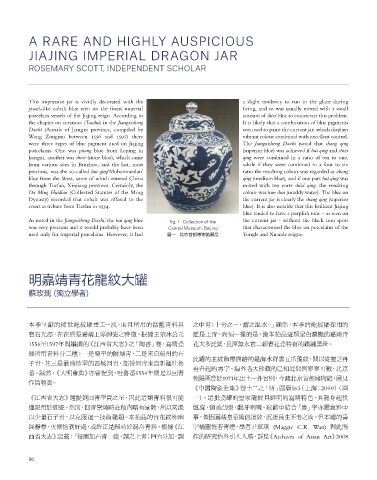Page 92 - Christie's Hong Kong November 29, 2022 Fine Chinese Works of Art
P. 92
A RARE AND HIGHLY AUSPICIOUS
JIAJING IMPERIAL DRAGON JAR
ROSEMARY SCOTT, INDEPENDENT SCHOLAR
This impressive jar is vividly decorated with the a slight tendency to run in the glaze during
jewel-like cobalt blue seen on the finest imperial firing, and so was usually mixed with a small
porcelain vessels of the Jiajing reign. According to amount of shizi blue to counteract this problem.
the chapter on ceramics (Taoshu) in the Jiangxisheng It is likely that a combination of blue pigments
Dazhi (Annals of Jiangxi province, compiled by was used to paint the current jar, which displays
Wang Zongmu between 1556 and 1597) there vibrant colour combined with excellent control.
were three types of blue pigment used on Jiajing The Jiangxisheng Dazhi noted that shang qing
porcelains. One was pitang blue from Leping in (superior blue) was achieved if hui qing and shizi
Jiangxi, another was shizi (stone blue), which came qing were combined in a ratio of ten to one,
from various sites in Ruizhou, and the last, most while if they were combined in a four to six
precious, was the so-called hui qing’Mohammedan’ ratio the resulting colour was regarded as zhong
blue from the West, some of which entered China qing (medium blue), and if one part hui qing was
through Turfan, Xinjiang province. Certainly, the mixed with ten parts shizi qing, the resulting
Da Ming Huidian (Collected Statutes of the Ming colour was hun shui (muddy water). The blue on
Dynasty) recorded that cobalt was offered to the the current jar is clearly the shang qing (superior
court as tribute from Turfan in 1554. blue). It is also notable that this brilliant Jiajing
blue tended to have a purplish tone – as seen on
As noted in the Jiangxisheng Dazhi, the hui qing blue fig. 1 Collection of the the current jar - without the black iron spots
was very precious and it would probably have been Capital Museum, Beijing that characterised the blue on porcelains of the
used only for imperial porcelains. However, it had 圖一 北京首都博物館藏品 Yongle and Xuande reigns.
明嘉靖青花龍紋大罐
蘇玫瑰 (獨立學者)
本季呈獻的稀世龍紋罐畫工一流,而且所用的鈷藍青料具 之中青;十分之一,謂之混水。」顯然,本季的龍紋罐採用的
寶石光澤,在在俱是嘉靖上等御瓷之特徵。根據王宗沐公元 應是上青。尚須一提的是,像本拍品這類呈色濃艷的嘉靖青
1556至1597年間編撰的《江西省大志》之「陶書」卷,嘉靖瓷 花大多泛紫,且渾無永宣二朝青花瓷特有的鐵鏽黑斑。
器所用青料分三種:一是樂平的陂塘青,二是來自瑞州的石
此罐的主紋飾帶描繪的是海水祥雲五爪龍紋,間以從靈芝冉
子青,其三是最為珍罕的西域回青,部份回青來自新疆吐魯
冉升起的壽字。海外各大珍藏的已知近似例寥寥可數,北京
番。誠然,《大明會典》亦曾提到,吐魯番1554年便是以回青
朝陽區曾於1971年出土一件實例,今藏北京首都博物館,圖見
作為朝貢。
《中國陶瓷全集》卷十二之「明」圖版163(上海:2000)(圖
《江西省大志》還提到回青罕貴之至,因此這類青料很可能 一)。這批瓷罐的皇家龍紋具鮮明的嘉靖特色,其龍身起伏
僅限用於御瓷。然而,回青窯燒時在釉內略有暈散,所以常混 盤旋,碩首凸眼,齜牙咧嘴。紋飾中結合「壽」字亦屬意料中
以少量石子青,以克服這一技術難題。本拍品的青花紋飾幽 事,蓋因嘉靖皇帝篤信道教,沉迷長生不老之術。但本罐的壽
深靜穆,火候恰到好處,或許正是歸功於混合青料。根據《江 字構圖恍若青煙,學者尹翠琪 (Maggie C.K. Wan) 對此所
西省大志》記載:「每兩加石青一錢,謂之上青;四六分加,謂 作的研究格外引人入勝,詳見《Archives of Asian Art》2008
86

